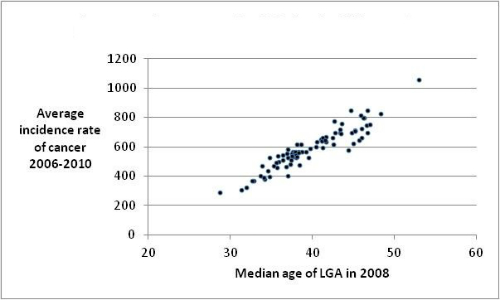
The incidence of cancer is defined to be the number of new cases diagnosed in a particular region and a particular year. The incidence rate is the number of new cases per 100,000 head of population.

a population is strongly associated with the median age of the population.
Now cancer is a notifiable disease in Australia, as in some other countries. All new cases of cancer, except for certain skin cancers, must be reported to the cancer registry in the state. Hence Australia has high quality data on the incidence of cancer that has been collected over many years. Much of the data are freely available on-line from the Australian Institute of Health and Welfare.
In Australia, a Local Government Area (LGA) is a defined region associated with some form of local government such as a city council, or shire council. In the state of Victoria in Australia, there are 79 LGAs.
This was calculated as the average incidence in the LGA for 2006-2010, per 100,000 head of population of the LGA in 2008. The incidence data were provided by Victorian Cancer Registry.
On the horizontal axis is the estimated median age of the population of the LGA in 2008. These estimates were calculated from population data available from the Australian Bureau of Statistics2.
The scatter diagram illustrates the strong association between the incidence rate of cancer in a population and the median age of the population. Spearman’s coefficient of correlation was r=.93, p<0.01.
I thank Victorian Cancer Registry, Cancer Council Victoria for providing the data on the incidence of cancer.




